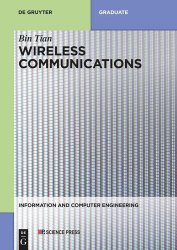 Название: Wireless Communications
Название: Wireless CommunicationsАвтор: Bin Tian
Издательство: China Science Publishing & Media Ltd./De Gruyter
Серия: Information and Computer Engineering
Год: 2024
Страниц: 258
Язык: английский
Формат: pdf (true), epub
Размер: 17.4 MB
This book presents the basic concepts, principles and technologies of wireless communication. The author focuses on the characteristics of the channel, the performance degradation, and various technologies to improve the performance of the wireless communication system. The upper technologies involved in building wireless performance are also discussed, and a prototype of the system is presented.
Wireless communication is a dynamic and vibrant area in the communication industry in the past decades due to several factors. Firstly, there has been an explosive increase in demand for wireless access, driven by cellular system and wireless data applications. Secondly, the dramatic progress in signal processing algorithms and VLSI technology has enabled small-area and low-power implementation of sophisticated processing and coding techniques. Thirdly, the successful standardization of wireless systems, such as the second-generation (2G) standards (GSM and IS-95), the third-generation (3G) standards (WCDMA, CDMA2000, TD-SCDMA and WiMAX), the fourth-generation (4G) standards (TD-LTE), and fifth generation (5G) under development, provides a concrete demonstration that good idea from wireless communications can have a significant impact on life. People have devoted great enthusiasm to wireless communication technology. Wireless communication has great economic benefits. It will produce very broad application prospects and will greatly change the way of people's learning, working and living. Wireless communication systems and networks are being installed everywhere throughout the world. People at any location use handheld wireless devices and laptops to remain connected to other people and information source.
The chapter and material sequence in this textbook have been designed mainly for postgraduate-level course. Chapter 1 gives an overview of the wireless communications and includes the history, the technical challenges, wireless systems and standards. Chapters 2 and 3 discuss the wireless channels. Chapter 2 deals with the large-scale path loss and shadowing, while Chapter 3 presents the small-scale fading and statistical multipath channel. In Chapter 4, we discuss the digital modulations and their performance over wireless channels. Chapters 5 to 7 discuss the techniques used in wireless systems to overcome the problems caused by fading. Chapter 5 discusses diversity, channel coding and equalization. In Chapter 6, we discuss spread spectrum systems and spread spectrum with RAKE receiver. Chapter 7 deals with multicarrier modulation and multi-antenna systems. In Chapter 8, we discuss techniques necessary to build a cellular system, such as duplexing, multiple access and cellular design fundamentals. We also include a simplified cellular system to ensure the reader understand how a cellular system works. We believe that the way of writing this book is helpful for readers to understand wireless communication more quickly and simply. We have not given the standard wireless systems, which involve more concepts and more factors resulting from the balance of interests in the formation of standards. However, we still recommend that readers pay attention to the latest information in the wireless communication industry and academia, the specific standards of wireless systems, and even the progress of new standards.
Скачать Wireless Communications (Information and Computer Engineering)